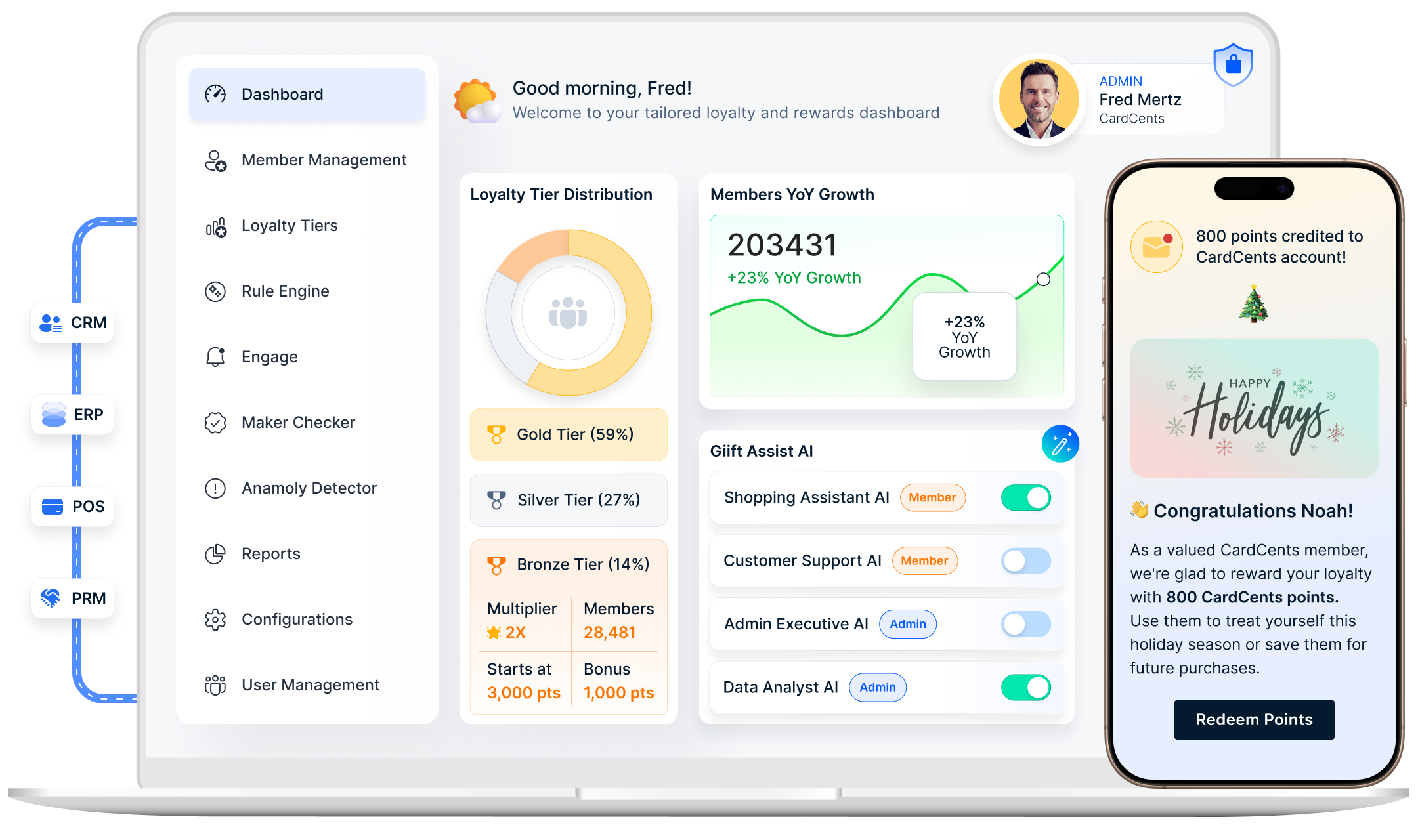On this page
Retaining customers is at the heart of every successful B2B business. But how do you know if your retention efforts are truly working? The answer lies in measuring the right metrics. Customer retention metrics provide valuable insights into how well your strategies are performing, helping you identify strengths, weaknesses, and opportunities to improve.
For B2B businesses, where long-term relationships and repeat business are key, understanding these metrics is even more critical. Metrics like churn rate, customer lifetime value, and net promoter score not only gauge retention but also shed light on the overall health of your customer relationships.
In this blog, we’ll cover 10 essential B2B customer retention metrics and explain how to measure them effectively. From tracking loyalty to predicting future revenue, these metrics will help you refine your approach and ensure your retention strategies deliver maximum impact.
What are customer retention metrics?
Customer retention metrics are key performance indicators (KPIs) that help businesses measure how effectively they are keeping their customers over time.
Unlike acquisition metrics, which focus on attracting new customers, retention metrics gauge customer loyalty and satisfaction, providing insights into the health of long-term relationships.
Why is customer retention important?
Why measuring customer retention rate is crucial
Measuring customer retention rate is essential because it provides valuable insights into how well your business maintains its customer base. Retention isn’t just about keeping customers—it's about fostering loyalty, ensuring repeat business, and driving sustainable growth. Here are key reasons why tracking this metric is so important:
1. Predicts long-term growth
A high retention rate often signals a healthy and sustainable business model. Loyal customers are more likely to make repeat purchases, recommend your brand, and drive steady revenue, making retention a reliable predictor of future success.
2. Identifies customer experience gaps
Retention metrics highlight how well you meet customer expectations. A declining retention rate can indicate underlying issues, such as poor service, unmet needs, or product shortcomings, enabling you to address these pain points proactively.
3. Maximises revenue potential
Retained customers typically spend more over time, especially as their trust in your brand grows. Measuring retention helps identify opportunities to upsell, cross-sell, and increase lifetime customer value, boosting profitability without significantly raising acquisition costs.
4. Reduces customer acquisition costs
Acquiring new customers is often more expensive than retaining existing ones. By improving your retention rate, you optimise resources and reduce dependency on costly acquisition strategies, ensuring a more efficient allocation of marketing budgets.
5. supports brand loyalty and advocacy
Loyal customers not only return—they also promote your brand. Retention metrics help you understand what drives loyalty and advocacy, allowing you to enhance these elements and convert customers into brand ambassadors.
6. Enables data-driven decision-making
Retention metrics provide actionable insights that help refine marketing, product development, and customer service strategies. They allow you to focus on initiatives that deliver the most impact on long-term customer satisfaction and loyalty.
7. Mitigates churn risks
Tracking retention helps identify patterns or triggers that lead to churn. Understanding these risks enables you to implement targeted strategies to address concerns, improve customer experience, and retain at-risk customers.
Key metrics to measure b2b customer retention strategies
To effectively measure and evaluate the success of your b2b customer retention efforts, it’s essential to track the following metrics.
1. Customer retention rate
The customer retention rate is a fundamental metric that indicates the percentage of customers retained over time. It is calculated by dividing the retained customers by the total customers at the start of the period and multiplying by 100.
A high CRR signifies strong customer loyalty and a successful retention strategy.
2. Customer churn rate
The customer churn rate is the percentage of customers who discontinue their relationship with your business over a specific period. It is the inverse of the customer retention rate.
Monitoring churn rate is critical to understanding the rate at which customers leave and can help identify areas for improvement in your retention efforts.
3. Customer lifetime value
Customer lifetime value estimates the total value a customer brings to your business over their relationship. It considers average purchase value, frequency of purchases, and more.
The metric helps quantify the financial impact of customer retention and informs decisions regarding resource allocation and prioritization.
4. Repeat purchase rate
It calculates the percentage of customers who make multiple purchases from your business. It reflects the level of customer engagement and satisfaction and the effectiveness of your retention strategies.
A higher repeat purchase rate indicates that customers value your offerings and will continue their business relationship.
According to a study, repeat customers spend 67% more than new customers, underscoring the importance of this metric for driving long-term profitability.
5. Net promoter score (NPS)
NPS is a widely used metric that gauges customer satisfaction by asking customers: “How likely are you to recommend our business to others?” Customers provide scores on a scale of 0 to 10.
According to Bain & Company, companies with high NPS scores grow at more than twice the rate of their competitors. A higher NPS indicates a loyal customer base likely to promote your brand.
Based on their responses, they are classified as promoters, passives, or detractors. NPS helps identify advocates who are more likely to refer others to your business, highlighting the effectiveness of your retention efforts.
6. Customer satisfaction (CSAT)
CSAT measures the level of satisfaction customers have with specific interactions and experiences with your business. It is assessed through surveys or feedback mechanisms.
Monitoring CSAT enables you to identify areas for improvement and proactively enhance the customer experience.
Research from Zendesk shows that a CSAT score of 80% or higher is often associated with a high level of customer satisfaction and loyalty, directly impacting retention rates.
7. Customer engagement rate
Customer Engagement Rate measures the level of interaction customers have with your brand, including website visits, social media activity, and usage of your product or service.
How to measure customer retention rate
Measuring customer retention rate is vital to understanding how well your business retains customers over time. Monitoring this metric will allow you to identify areas for improvement in your retention strategy and take action to improve customer loyalty.
Here’s how to measure customer retention rate:
1. Define the timeframe
The first step is to define the period you want to measure, such as a month, quarter, or year. Your chosen period will depend on your business and how frequently customers interact with your brand.
2. Determine your starting point
To calculate the retention rate, you need to know the number of customers you started with at the beginning of the period. You can determine that by looking at your customer database or sales records.
3. Count your retained customers
Next, you need to count the number of customers who made repeat purchases or remained active during the period. This number represents your retained customers.
4. Calculate the retention rate
To calculate the retention rate, divide the number of retained customers by the total number of customers at the beginning of the period and then multiply by 100 to get a percentage. For example, if you started the month with 1,000 customers and ended with 900, your retention rate would be 90%.
Retention Rate = (Number of Retained Customers / Total Number of Customers at the Beginning of the Period) x 100
5. Analyze your results
Once you have calculated your retention rate, it’s important to analyze the results. Is your retention rate high or low compared to industry benchmarks? Are there any trends or patterns you can identify, such as a dip in retention during a specific period or for a particular product or service?
6. Take action
Based on your analysis, take action to improve your retention rate. Consider implementing retention tactics, like improving customer service, offering loyalty rewards, or providing personalized experiences. Continuously monitor your retention rate and adjust your strategy as needed.
How to combine qualitative and quantitative insights
Numbers can provide a wealth of information, but they rarely tell the complete story. That’s where qualitative insights step in. By blending measurable data (quantitative insights) with detailed, narrative feedback (qualitative insights), you gain a deeper understanding of not only what’s happening with customer retention but also why it’s happening. It’s like understanding both the storyline of a movie and the characters’ motivations that bring it to life.
For instance, a decline in your Net Promoter Score (NPS) might signal dissatisfaction, but it won’t pinpoint the exact problem. However, examining specific feedback from detractors can uncover recurring issues, such as a challenging onboarding process or the absence of a critical feature for your core users. These insights shed light on the “why” behind the “what” and guide you toward creating focused strategies to reduce churn.
By aligning qualitative and quantitative insights, you move beyond speculation to build retention strategies rooted in real customer challenges. Here’s how to effectively combine these two approaches:
Framework for implementation
- Regularly survey your customers: Utilize tools like NPS, CSAT, or customer feedback surveys to gauge user sentiment. Timing matters—survey customers after key moments, such as onboarding, using new features, or post-support interactions, to gather feedback tied to specific experiences.
- Connect qualitative feedback to quantitative metrics: When a key metric dips—like customer retention rates or churn spikes—turn to qualitative insights for explanations. Look for recurring themes in feedback, such as slow support response times or confusion over a new feature, to identify the root causes.
- Prioritize actions based on impact: Not every piece of feedback carries the same weight. Focus on addressing issues that significantly impact critical metrics. For example, dissatisfaction among high-value customers should take precedence over minor concerns raised by a few non-paying users.
- Close the loop with customers: Establish a process for acting on feedback and communicating those changes to your customers. Transparency fosters trust. When users feel their voices are heard, they are more likely to remain loyal and even advocate for your brand.
- Test, refine, and measure: After implementing changes, monitor both quantitative metrics and qualitative feedback to assess the impact. Have satisfaction scores risen? Has churn decreased? Use these insights to iteratively refine your approach for continuous improvement.
Why this approach matters
Combining qualitative and quantitative insights allows you to uncover gaps in your data, better understand customer experiences, and develop retention strategies that address actual pain points. This dual approach ensures you’re not relying solely on numbers, which often lack context, or feedback, which can be subjective. Instead, you create a balanced and comprehensive strategy.
By integrating both types of insights, your team can proactively address potential churn factors before they escalate into larger problems. This holistic method equips you with the tools to foster lasting growth and meaningful customer relationships.
Skyrocket your customer retention rate with Loyalife

Loyalife offers a comprehensive solution to enhance customer retention through personalized and engaging loyalty programs.
By integrating seamlessly with existing CRM, marketing, and transaction systems, Loyalife enables businesses to create tailored experiences that resonate with their customers.
The platform's advanced analytics provide actionable insights into customer behavior, allowing for proactive engagement strategies that foster long-term loyalty.
Key features:
- Customizable loyalty programs: Design programs that align with specific industry needs, ensuring relevance and effectiveness.
- Real-time data analytics: Access actionable insights into customer behavior, enabling proactive engagement strategies.
- Seamless integration: Connect effortlessly with existing CRM, marketing, and transaction systems for a unified customer experience.
Contact our loyalty experts today to boost your B2B customer retention rate. Our team will work with you to understand your needs and help you achieve exceptional customer retention results.
FAQ's
1. What is a Net Promoter Score (NPS), and why is it important?
NPS is a metric that measures customer satisfaction and loyalty by asking customers how likely they are to recommend a company’s product or service. A high NPS score correlates with higher customer retention rates.
2. How does customer satisfaction (CSAT) impact retention?
CSAT measures how satisfied customers are with a product, service, or experience. Higher CSAT scores are directly linked to better customer retention, as satisfied customers are more likely to stay loyal and continue doing business.
3. What is the relationship between retention rate and revenue growth?
High retention rates typically lead to higher revenue growth. Retained customers are more likely to make repeat purchases, upgrade services, or refer new clients, all of which contribute to long-term revenue increases.
4. What is the retention cost?
Retention cost refers to the expenses associated with retaining existing customers, such as loyalty programs, customer service, and engagement initiatives. It’s essential to balance retention costs with the value generated from loyal customers.
5. How can referral rates indicate customer retention?
Referral rates measure the likelihood of customers recommending a business to others. Higher referral rates suggest strong customer satisfaction and loyalty, key indicators of successful retention strategies.
6. How does customer engagement relate to retention?
Customer engagement measures how actively customers interact with a business. Higher engagement often leads to higher retention, as engaged customers are more likely to stay loyal, provide feedback, and participate in additional offerings.
7. What is the impact of onboarding on customer retention metrics?
Effective onboarding is crucial for retention. A smooth onboarding process helps customers quickly realize the value of a product or service, leading to higher satisfaction and lower churn rates.
8. How do upsell and cross-sell metrics affect retention?
Upselling and cross-selling opportunities are indicators of a healthy customer relationship. Successfully upselling or cross-selling enhances the customer experience and increases customer lifetime value, both of which contribute to retention.
9. What role does customer service play in retention metrics?
Exceptional customer service directly impacts retention by ensuring customer satisfaction, resolving issues promptly, and strengthening trust. Businesses with strong customer service tend to have lower churn rates and higher retention rates.
10. How can businesses improve retention based on these metrics?
To improve retention, businesses should regularly monitor their retention metrics, identify pain points, and implement targeted strategies such as personalized offers, loyalty programs, and improved customer service. Using these insights helps refine retention strategies for better results.









